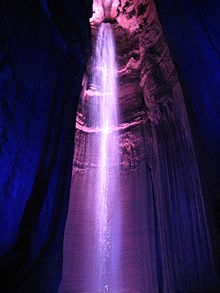

A subterranean waterfall, tierous waterfall, or underground waterfall is a waterfall located underground, usually in a cave or mine. They are a common feature in cave systems where there are vertical or near vertical geological structures for the weathering process to exploit, and sufficient gradient between the sink and the rising. Notable examples include Ruby Falls, 44 metres (144 ft) high, in Chattanooga, Tennessee and Gaping Gill in the Yorkshire Dales, UK with a fall of 98 metres (322 ft). The highest known subterranean waterfall is in Vrtoglavica Cave in Slovenia, and is at least 400 metres (1,300 ft).
See also
References
- Kevin Adams (1 June 2002). Waterfalls of Virginia and West Virginia: A Hiking and Photography Guide. Menasha Ridge Press. p. 32. ISBN 978-0-89732-414-4.
- Waltham, Tony; Murphy, Phil (2013). Waltham, Tony; Lowe, Dave (eds.). Caves and Karst of the Yorkshire Dales. Buxton: British Cave Research Association. p. 136. ISBN 978-0900265-46-4.
- "Tennessee's Spectacular Underground Waterfall". The Weather Channel. 21 March 2014. Retrieved 4 April 2016.
- Pavils, Gatis (7 March 2013). "Vrtiglavica Cave and Waterfall". Wondermondo. Retrieved 4 April 2017.
| Cave topics | |
|---|---|
| Glossary of caving and speleology | |
| Main topics | |
| Types and formation processes | |
| Speleothems and Speleogens (Cave formations) | |
| Dwellings | |
| Popular culture | |
| Incidents | |